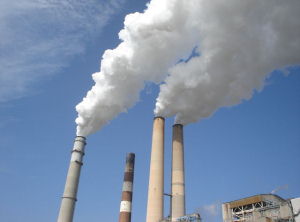On April 14, 2016, the United States Environmental Protection Agency confirmed that it is appropriate and necessary to regulate air toxics, including mercury, from power plants after including a consideration of costs.
Background:

© US DOE
|
According to US EPA, power plants are the largest industrial source of mercury pollution in the U.S.A. and they emit more than half of a range of air toxics, as well as sulfur dioxide and particulates. Based on the determination that air toxic emissions, most notably mercury, pose hazards to public health and the environment and that there are available controls to reduce air toxic emissions from these units, EPA determined on December 20, 2000, that it is appropriate to regulate coal- and oilfired power plants. On February 16, 2012, EPA published final air toxics standards for coal- and oil-fired power plants also known as the Mercury Air Toxics Standards or "MATS". The power industry and several states had challenged the rules in federal court. Last June, without blocking the rules from going forward, the Supreme Court said the EPA had failed to properly consider how much their implementation would cost power plants.
The analysis released on Friday, April 15, is EPA's answer to the requirement of a cost analysis demanded by the Supreme Court. The new analysis reaffirms prior determination which shows that compliance with MATS is a very cost-effective way to very significantly reduce a whole host of very dangerous pollutants. The EPA estimated that, nationwide, the new standards would have about $90 billion a year in health benefits, preventing up to 11,000 premature deaths, 4,700 heart attacks and 130,000 asthma attacks annually.
 Related information
Related information US EPA: Mercury and Air Toxics Standard (MATS)
US EPA: Mercury and Air Toxics Standard (MATS)
 US EPA: MATS Regulatory Actions
US EPA: MATS Regulatory Actions
 UNEP: Reducing Risk from Mercury
UNEP: Reducing Risk from Mercury
 BRI
- Report: Mercury in the Global Environment: Patterns of Global Seafood
Mercury Concentrations and their Relationship with Human Health
BRI
- Report: Mercury in the Global Environment: Patterns of Global Seafood
Mercury Concentrations and their Relationship with Human Health
 Zero Mercury Working Group - Report: Mercury Contamination, Exposures and Risk: A New Global Picture Emerges, December 2012
Zero Mercury Working Group - Report: Mercury Contamination, Exposures and Risk: A New Global Picture Emerges, December 2012
 Related EVISA Resources
Related EVISA Resources
 Link Database: Toxicity of Organo-mercury compounds
Link Database: Toxicity of Organo-mercury compounds  Link Database: Mercury exposure through the diet
Link Database: Mercury exposure through the diet  Link Database: Environmental cycling of methylmercury
Link Database: Environmental cycling of methylmercury Link Database: Environmental cycling of inorganic mercury
Link Database: Environmental cycling of inorganic mercury Link Database: Environmental pollution of methylmercury
Link Database: Environmental pollution of methylmercury Link Database: Environmental pollution of inorganic mercury
Link Database: Environmental pollution of inorganic mercury Link Database: Toxicity of mercury
Link Database: Toxicity of mercury  Related EVISA News
Related EVISA News
 January 14, 2016: EVISA News revisited: Dissension on the best way to fight mercury pollution
January 14, 2016: EVISA News revisited: Dissension on the best way to fight mercury pollution
 September 2, 2014: Man is significantly contaminating oceans with mercury
September 2, 2014: Man is significantly contaminating oceans with mercury
 October 12, 2013: Minamata Convention is adopted (12.10.2013)
October 12, 2013: Minamata Convention is adopted (12.10.2013)
 January 14, 2013: Mercury Levels in Humans and Fish Around the World Regularly Exceed Health Advisory Levels
January 14, 2013: Mercury Levels in Humans and Fish Around the World Regularly Exceed Health Advisory Levels
 June 17, 2012: Factors Affecting Methylmercury Accumulation in the Food Chain
June 17, 2012: Factors Affecting Methylmercury Accumulation in the Food Chain  January 25, 2012: New Report Shows High Levels of Mercury in Terrestrial Ecosystems
January 25, 2012: New Report Shows High Levels of Mercury in Terrestrial Ecosystems  December 19, 2011: Anthropogenic Mercury Releases Into the Atmosphere from Ancient to Modern Time
December 19, 2011: Anthropogenic Mercury Releases Into the Atmosphere from Ancient to Modern Time  May 5, 2009: Ocean mercury on the rise
May 5, 2009: Ocean mercury on the rise  October 9, 2006: Linking atmospheric mercury to methylmercury in fish
October 9, 2006: Linking atmospheric mercury to methylmercury in fish  August 16, 2006: Mercury pollution threatens health worldwide, scientists say
August 16, 2006: Mercury pollution threatens health worldwide, scientists say  September 13, 2005: Regulating Mercury Emissions from Power Plants: Will It Protect Our Health?
September 13, 2005: Regulating Mercury Emissions from Power Plants: Will It Protect Our Health?  April 3rd, 2005: Dissension on the best way to fight mercury pollution
April 3rd, 2005: Dissension on the best way to fight mercury pollution last time modified: April 20, 2016